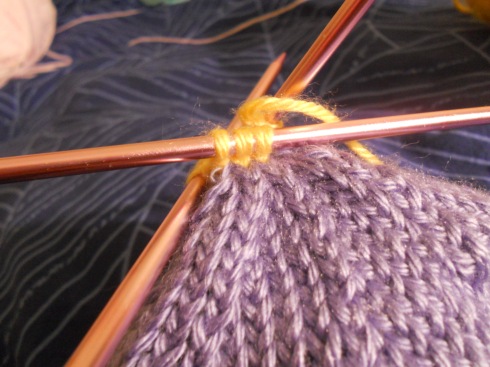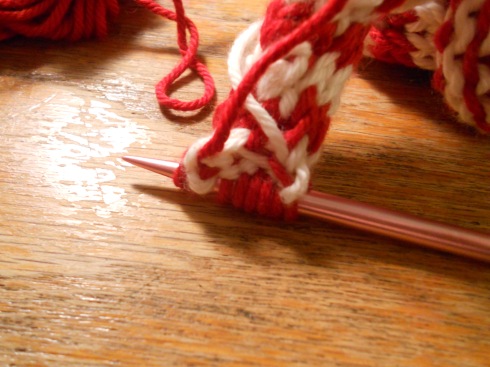So hopefully the last project I posted gave people lots of festive ideas and helped get you in the holiday spirit. However, I will now be changing gears at lightning speed and bringing you something much more suited for spring:
This upside-down daisy hat (from the previously mentioned excellent Itty-Bitty Hats by Susan B. Anderson) is probably one of the best received projects I’ve ever done. When I was first getting into knitting this past summer, my first non-scarf project were plain baby hats for my nieces. After I was able to master those with minimal difficulty, I saw the pattern for this hat and decided to give it a try. Initially I was worried that it would be too complicated, but I found it to be surprisingly simple and was able to make the ones for my nieces with very little gnashing of teeth. Once family members and friends saw it, I started getting requests. Seriously. I felt like a DJ. So that’s how I ended up knitting one for a family friend’s daughter:
And then my mom wanted me to knit one for one of her work friends who had a baby, which is how I ended up doing this current hat. Because I’ve now done this project four separate times, I think that I’ve got a pretty good handle on it. This last hat went very quickly and easily for me, so if you’re an experienced knitter it should be pretty simple.
That having been said, if you’ve never knit a hat with circular and double pointed needles, it does take a little while to get used to. The fact that the ‘stem’ of this flower is so small makes is somewhat trickier to knit, so if you’re nervous maybe try knitting a basic hat first and then moving up to this one (Itty-Bitty Hats has got great, clear patterns for basic hats).
The pattern calls for Rowan Handknit Cotton (which is a DK weight), but the first time I knit the pattern I had some Caron Simply Soft (which is a medium weight) lying around so that was what I used. I’ll be honest, at the time I had a very limited understanding of yarn weights. I later realized when I got the Rowan for the candy cane hat I made that by using the Caron I’d used a completely different weight than what the pattern called for (whoopsies!). However, I really liked the way that it turned out in the Caron, so I’ve just used it ever since. If you do choose to use the Caron, the final product might be somewhat bigger than it would be with the Rowan, but I haven’t had any huge issues with them not fitting. Also, the beautiful thing about babies is that they keep getting bigger, so even if it’s on the large side they can grow into it.
Now, onto the knitting!
The hat starts out with a long tail cast on onto circular needles and you simply knit until the hat reaches the length indicated in the pattern. The decrease sequence then begins while you’re on the circular needles and relies solely on knitting 2 stitches together, which makes it nice and simple.
You then transition to circular needle and continue the decrease sequence until you get to a small number of stitches (between 7 and 11, depending on the size of the hat you’d like). You then change to the color you’re using for the center of the flower and continue to knit on the double pointed needles for a few rounds.
The pattern called for a shell color for the center, but I prefer the bright yellow as it makes is look more like a real flower (even though you wouldn’t see the yellow if it were actually an upside-down daisy… minor detail).
After a few rounds of yellow, you then switch over to the green for the stem and work it as I-cord for a few inches. Then you bind off and are finished with the body of the hat.
You then make 5 or 6 petals (depending on the size of the hat) by using your double pointed needles as regular needles. While the pattern shows the petals with a fairly round edge, I’ve found that I actually prefer attaching them opposite to the way they were intended (i.e., I attach the intended tip of the petal to the stem rather than the intended base). This means that I end up with a nice flat end to attach to the stem and a pointed petal that results from the bind off, which I personally feel looks better. Either way works though, so go nuts! Then, pin the petals to the hat so that you can figure out where they need to go. It pays to be pretty precise when doing this so you don’t have to go back and remove petals if they’re not lined up right.
You then begin to sew on the petals using a yarn needle. I’ve found that I get the best results when I stitch in a way that mimics the stockinette edge of the petal (i.e., at a downward sloping angle rather than straight up and down.)
Generally it blends in fairly well and ends up looking pretty clean.
Well that’s it! I hope you can forgive my blatant season hopping. This will probably be a great project to do in February when it’s snowy and terrible and you’d sell your soul just to see a real flower in bloom. This hat won’t quite fill the void, but hat + baby = more awesome than any real flower ever could be.



















